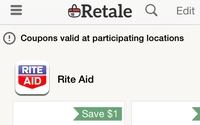 Mobile coupons are on the rise, which should come as no surprise.
Mobile coupons are on the rise, which should come as no surprise.
This is hardly to say paper coupons are dying, though the economics would imply they should be.
A mailed coupon costs a brand or retailer 25 cents, a printed newspaper coupon costs about 5
cents and a coupon that a consumer prints at home costs a retailer pretty much nothing, based on a recent study by Juniper Research.
Only about one percent of paper coupons are redeemed,
fueling the natural migration to digital.
But a coupon delivered to a mobile phone can be much more relevant than one to a PC, causing a major move to mobile coupons.
More than 31
billion digital coupons will be redeemed annually within three years, up from about 16 billion this year, according to Juniper. And most of those will come via mobile devices.
Of the 31
billion digital coupons, almost three quarters (73%) will come via mobile, with most (85%) not printed at home.
The digital writing is on the wall.
There are numerous indications that
mobile coupons and their redemption rates could be explosive.
This is not only because consumers like deals, but also because they’re becoming easier to attain. This is one of the
reasons that apps like RetailMeNot, Retale and SnipSnap are so hot: they deliver deals where and when shoppers want them, near or in a store.
And it’s likely to get even easier.
The monster retail mobile payment venture CurrentC plans to automatically apply coupons and loyalty programs during the payment process, as we wrote about here yesterday (Softcard, CurrentC: The New, Big Names in Mobile Payments).
Coupons are
starting to find consumers rather than consumers finding them.
In one recent back-to-school study of 1,000 parents with school-aged children conducted by the Toluna Research Group for Retale,
the large majority (92%) of mobile shoppers access coupons.
Of mobile shoppers who want to receive relevant ads while in a store, almost half (47%) said they wanted to receive coupons, the top
choice, based on a study of 200 consumers in charge of back-to-school shopping for their families, conducted by Google Consumer Surveys for Thinknear by Telenav.
Like many other aspects of
mobile commerce, not all segments in the market transition are impacted identically or at least at the same time.
For example, the majority of grocery store brands still rely on consumers to
print coupons at home for in-store redemption, according to research by L2.
While more than a third (36%) of food brands have coupon sections on their websites, only a quarter (24%) offer them
during the time that consumers are researching, searching and collecting data period of their shopping trip.
About 329 billon coupons for consumer packaged goods were distributed last year and
3 billion were redeemed, according to the Inmar 2014 Coupon Trends Report.
There are some very big coupon numbers poised to move to mobile.